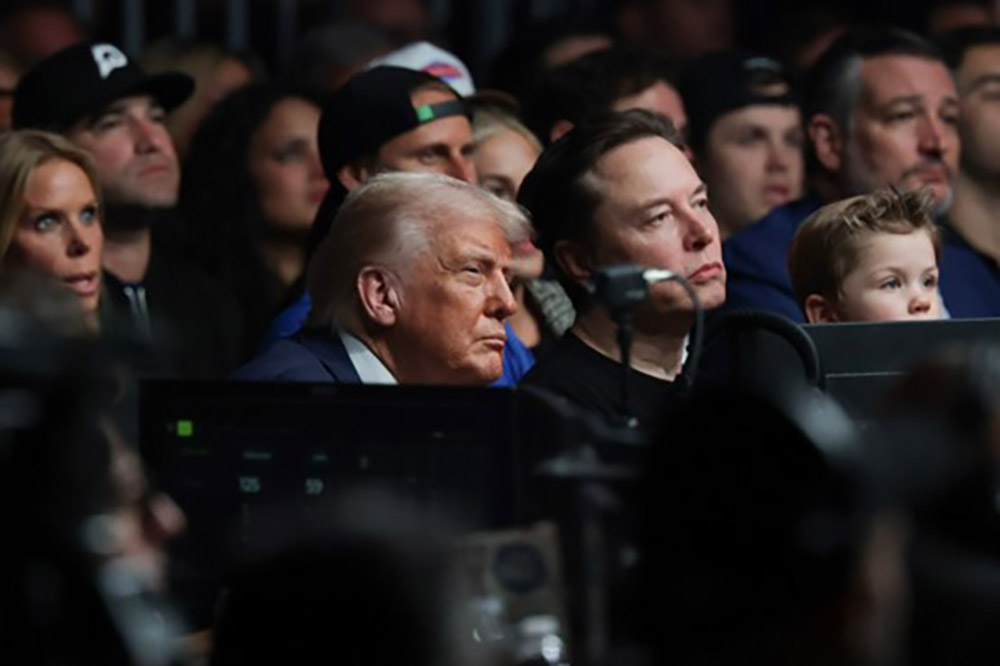
即便是一贯看好特斯拉的分析师群体,也纷纷对该公司第一季度业绩恐将让投资者大失所望发出预警,这一论断在4月初披露季度交付数据欠佳时便已初现端倪。
但4月22日股市收盘后公布的数据远比预期要糟糕得多。
特斯拉汽车销售额较去年同期下降20%,降至140亿美元。尽管工业和家用电池储能业务在过去一年实现强劲增长,但公司整体营收仍骤降9%。销售额下滑严重侵蚀了盈利能力,导致净利润下降近40%,至4.09亿美元,远低于华尔街预测的逾6亿美元,仅为特斯拉2023年第二季度盈利的六分之一。
当业绩惨淡到远低于“市场预期”时,其股价在后续数日暴跌几乎已成定局。然而,马斯克再次凭借其出色的表演能力力挽狂澜。在电话会议上,他宣称自5月起,将卸去在特朗普政府效率部中“厉行节约的强硬派”角色,转而“将把更多时间分配给特斯拉”。这位世界首富还成功地将投资者的目光从惨淡的新业绩数据转移到对未来的美好憧憬上,宣称备受瞩目的Model Y跑车将于今年稍晚时候推出,而特斯拉的自动驾驶出租车也将于2026年开始在总部所在地奥斯汀载客运营。
因此,当4月24日纽约证券交易所收盘钟声响起时,特斯拉股价较第一季度财报公布前飙升9%,达到每股260美元。在这一天半的时间里,特斯拉市值增加了670亿美元,使其估值达到8360亿美元。
问题在于:在此次出人意料的飙升之前,特斯拉股价已然被严重高估。
过去一个季度,特斯拉“核心”业务出现亏损
特斯拉目前在奥斯汀、柏林和上海生产的产品仅能支撑其估值的冰山一角。而且这些产品的前景正在迅速恶化。至于其余的部分——尽管第一季度业绩惨淡,其股价却逆势上扬——或许可称之为“马斯克愿景溢价”。
在去年第四季度财报(同样糟糕但程度稍轻)发布后,笔者引入了一个新概念来衡量特斯拉现有业务(几乎完全由汽车、电池构成,外加少量服务业务)所创造的可重复性核心收益。为此,笔者剔除了一次性收益,包括2023年第四季度的巨额税收优惠,以及该季度因比特币持仓增值6亿美元带来的非现金收益。笔者还排除了向竞争对手出售监管积分所获得的收益——马斯克本人也表示这项收益难以持久,不过其消退速度仍难以预测。
我们称之为“核心”利润,这表明特斯拉庞大的市值中有多少是基于其当前的业绩,又有多少是得益于“马斯克愿景溢价”,即这位明星首席执行官对特斯拉买家的全自动驾驶软件与车辆以及商用自动驾驶出租车的承诺。截至目前,这些承诺似乎总是遥不可及。
为了得出“核心”利润数值,笔者以4.09亿美元净利润为起点,然后扣除出售监管积分所获税后利润,最终得出4.33亿美元,超过了特斯拉第一季度总利润。根据笔者计算,特斯拉今年第一季度在汽车及电池的生产与销售环节,亏损达1300万美元,这也是自2020年以来首次出现此类状况。
过去四个季度,特斯拉“核心”(理论上“可重复”)利润为35亿美元。据此计算,经调整后的市盈率(特斯拉目前的估值8360亿美元除以35亿美元)为240倍。值得一提的是,在2022年巅峰时期,特斯拉全年“核心利润”接近120亿美元,是过去12个月盈利的三倍有余。
我们不妨给汽车电池业务定一个20倍的市盈率,这已经是全球行业平均水平的两倍了,算是相当慷慨了。这样一来,特斯拉当前正常运营的业务估值也仅为700亿美元。而7660亿美元的估值差额,本质上是对马斯克在未来多年推动特斯拉实现持续盈利增长的盲目笃信,然而这种增长态势,在资本主义的发展历程中极为罕见——未曾有与特斯拉规模、发展阶段相近的企业达成过。
若投资者期望从当前持仓获取10%的年化回报,特斯拉股价需在7年内实现翻倍,从当前的260美元攀升至520美元。诚然,特斯拉股价数月前几近达到这一水平。但与特朗普当选后那段狂热时期相比,如今特斯拉的前景要黯淡得多。实现这一目标,意味着特斯拉的市值必须翻倍,突破1.6万亿美元大关。即便再次给出乐观的30倍市盈率的预测,那么所需的净利润也将远超500亿美元。仅靠汽车业务是无法实现的。特斯拉需要在那些还停留在设计图纸和原型阶段、尚未推向市场的产品上获得相当于苹果(Apple)目前一半的收入。
看起来马斯克又一次迷惑了投资者的心智
特斯拉在第一季度的新闻稿中,将惨淡业绩归咎于“汽车和能源市场的不确定性持续加剧,快速演变的贸易政策对特斯拉及其同行的全球供应链和成本结构造成负面影响”。换言之,特斯拉是在指责马斯克在白宫的“上司”(指特朗普)。
在音乐电影《欢乐音乐妙无穷》(The Music Man)中,巧舌如簧的推销员哈罗德·希尔(Harold Hill)成功说服里弗城(River City,虚构的)的淳朴市民为一车又一车即将运抵的长号和单簧管买单。希尔用华丽辞藻勾勒出一支辉煌军乐队的图景,令众人沉醉其中。但若论“忽悠”功夫,这位“冒牌音乐教授”和埃隆·马斯克比起来可就小巫见大巫了。 (财富中文网)
译者:中慧言-王芳
即便是一贯看好特斯拉的分析师群体,也纷纷对该公司第一季度业绩恐将让投资者大失所望发出预警,这一论断在4月初披露季度交付数据欠佳时便已初现端倪。
但4月22日股市收盘后公布的数据远比预期要糟糕得多。
特斯拉汽车销售额较去年同期下降20%,降至140亿美元。尽管工业和家用电池储能业务在过去一年实现强劲增长,但公司整体营收仍骤降9%。销售额下滑严重侵蚀了盈利能力,导致净利润下降近40%,至4.09亿美元,远低于华尔街预测的逾6亿美元,仅为特斯拉2023年第二季度盈利的六分之一。
当业绩惨淡到远低于“市场预期”时,其股价在后续数日暴跌几乎已成定局。然而,马斯克再次凭借其出色的表演能力力挽狂澜。在电话会议上,他宣称自5月起,将卸去在特朗普政府效率部中“厉行节约的强硬派”角色,转而“将把更多时间分配给特斯拉”。这位世界首富还成功地将投资者的目光从惨淡的新业绩数据转移到对未来的美好憧憬上,宣称备受瞩目的Model Y跑车将于今年稍晚时候推出,而特斯拉的自动驾驶出租车也将于2026年开始在总部所在地奥斯汀载客运营。
因此,当4月24日纽约证券交易所收盘钟声响起时,特斯拉股价较第一季度财报公布前飙升9%,达到每股260美元。在这一天半的时间里,特斯拉市值增加了670亿美元,使其估值达到8360亿美元。
问题在于:在此次出人意料的飙升之前,特斯拉股价已然被严重高估。
过去一个季度,特斯拉“核心”业务出现亏损
特斯拉目前在奥斯汀、柏林和上海生产的产品仅能支撑其估值的冰山一角。而且这些产品的前景正在迅速恶化。至于其余的部分——尽管第一季度业绩惨淡,其股价却逆势上扬——或许可称之为“马斯克愿景溢价”。
在去年第四季度财报(同样糟糕但程度稍轻)发布后,笔者引入了一个新概念来衡量特斯拉现有业务(几乎完全由汽车、电池构成,外加少量服务业务)所创造的可重复性核心收益。为此,笔者剔除了一次性收益,包括2023年第四季度的巨额税收优惠,以及该季度因比特币持仓增值6亿美元带来的非现金收益。笔者还排除了向竞争对手出售监管积分所获得的收益——马斯克本人也表示这项收益难以持久,不过其消退速度仍难以预测。
我们称之为“核心”利润,这表明特斯拉庞大的市值中有多少是基于其当前的业绩,又有多少是得益于“马斯克愿景溢价”,即这位明星首席执行官对特斯拉买家的全自动驾驶软件与车辆以及商用自动驾驶出租车的承诺。截至目前,这些承诺似乎总是遥不可及。
为了得出“核心”利润数值,笔者以4.09亿美元净利润为起点,然后扣除出售监管积分所获税后利润,最终得出4.33亿美元,超过了特斯拉第一季度总利润。根据笔者计算,特斯拉今年第一季度在汽车及电池的生产与销售环节,亏损达1300万美元,这也是自2020年以来首次出现此类状况。
过去四个季度,特斯拉“核心”(理论上“可重复”)利润为35亿美元。据此计算,经调整后的市盈率(特斯拉目前的估值8360亿美元除以35亿美元)为240倍。值得一提的是,在2022年巅峰时期,特斯拉全年“核心利润”接近120亿美元,是过去12个月盈利的三倍有余。
我们不妨给汽车电池业务定一个20倍的市盈率,这已经是全球行业平均水平的两倍了,算是相当慷慨了。这样一来,特斯拉当前正常运营的业务估值也仅为700亿美元。而7660亿美元的估值差额,本质上是对马斯克在未来多年推动特斯拉实现持续盈利增长的盲目笃信,然而这种增长态势,在资本主义的发展历程中极为罕见——未曾有与特斯拉规模、发展阶段相近的企业达成过。
若投资者期望从当前持仓获取10%的年化回报,特斯拉股价需在7年内实现翻倍,从当前的260美元攀升至520美元。诚然,特斯拉股价数月前几近达到这一水平。但与特朗普当选后那段狂热时期相比,如今特斯拉的前景要黯淡得多。实现这一目标,意味着特斯拉的市值必须翻倍,突破1.6万亿美元大关。即便再次给出乐观的30倍市盈率的预测,那么所需的净利润也将远超500亿美元。仅靠汽车业务是无法实现的。特斯拉需要在那些还停留在设计图纸和原型阶段、尚未推向市场的产品上获得相当于苹果(Apple)目前一半的收入。
看起来马斯克又一次迷惑了投资者的心智
特斯拉在第一季度的新闻稿中,将惨淡业绩归咎于“汽车和能源市场的不确定性持续加剧,快速演变的贸易政策对特斯拉及其同行的全球供应链和成本结构造成负面影响”。换言之,特斯拉是在指责马斯克在白宫的“上司”(指特朗普)。
在音乐电影《欢乐音乐妙无穷》(The Music Man)中,巧舌如簧的推销员哈罗德·希尔(Harold Hill)成功说服里弗城(River City,虚构的)的淳朴市民为一车又一车即将运抵的长号和单簧管买单。希尔用华丽辞藻勾勒出一支辉煌军乐队的图景,令众人沉醉其中。但若论“忽悠”功夫,这位“冒牌音乐教授”和埃隆·马斯克比起来可就小巫见大巫了。 (财富中文网)
译者:中慧言-王芳
Even the perma-bull crowd of analysts covering Tesla warned of sorely disappointing results in Q1, a view signaled by the poor deliveries for the quarter reported in early April.
But the numbers released after the market close on April 22 were much, much worse than expected.
Automotive sales tumbled 20% over the same period last year to $14 billion. Despite a strong 12-month gain in its industrial and residential battery storage franchise, overall revenues plunged 9%. Falling sales hammered profitability, sending net income down nearly 40% to a piddling $409 million, far below the over $600 million forecast by Wall Street, and one-sixth of what Tesla earned as recently as Q2 of 2023.
When results fall this disastrously short of “consensus,” it’s virtually a given that the stock craters in the days that follow. But Musk staged yet another triumph of showmanship to save the day. On the conference call he declared that, starting in May, he’ll be stepping back from his role as President Trump’s spending hawk at DOGE, and will be “allocating far more time to Tesla.” The world’s richest person also succeeded in shifting investors’ gaze from the miserable new numbers to the rich promise of things to come, declaring that a long-awaited version of the Model Y sports vehicle will arrive later this year, and that Tesla robotaxis will ferry passengers around its hometown of Austin starting in 2026.
So when the NYSE closing bell sounded Thursday, April 24, Tesla shares had jumped 9% from the level prior to the Q1 report to $260. In that day-and-a-half span, Tesla added $67 billion in market cap, raising its valuation to $836 billion.
The rub: Tesla’s shares already looked radically overvalued prior to this unlikely spike. Here’s why.
In the past quarter, Tesla lost money in its ‘hardcore’ businesses
The products Tesla is now producing in Austin, Berlin, and Shanghai explain only a small fraction of its valuation. And their fortunes are falling fast. The rest—which just got even pricier in defiance of the Q1 debacle—might be called the “Musk Hope Premium.”
Following the bad, but not-nearly-as-bad Q4 report, this writer introduced a new concept for measuring Tesla’s repeatable, bedrock earnings generated by its current businesses—almost exclusively comprising cars and batteries, plus a small services unit. To get there, I eliminated such one-time gains as a big tax benefit in the final quarter of 2023, and a noncash profit on the $600 million write-up of its Bitcoin holdings in Q4. I also excluded earnings from the sale of regulatory credits to competing carmakers, a benefit that Musk himself says will prove ephemeral, though how fast it fades remains unpredictable.
What we’ll term these “hardcore” profits show how much of Tesla’s gigantic market cap is justified by what it’s doing now, and how much owes to the “Musk Hope Premium,” the celebrity CEO’s promises for full self-driving software and vehicles for Tesla buyers, and commercial robotaxis. So far, those assurances have proved a constantly receding horizon.
To get the “hardcore” number, I started with net earnings of $409 million, and subtracted after-tax profits from the sale of regulatory credits. That result is $433 million, and accounts for over 100% of Tesla’s total profits. By my calculus, Tesla lost $13 million making and selling cars and batteries in Q1. It’s the first time that’s happened since 2020.
For the past four quarters, Tesla has posted a “hardcore,” hopefully “repeatable” number of $3.5 billion. Hence, it’s now selling at an adjusted P/E of 240 (the $836 billion valuation divided by my profit number of $3.5 billion). By the way, at its peak in 2022, Tesla’s “hardcore number” for the year was almost $12 billion, over three times what it achieved in the past 12 months.
Let’s give the car-battery business a P/E of 20, twice the global industry average, just to be generous. That puts the worth of its currently up-and-running operations at $70 billion. The entire difference of $766 billion is essentially a blind vote of confidence that Musk will deliver years of earnings growth from here seldom witnessed in the annals of capitalism and never achieved by a player of Tesla’s age and size.
If you want a 10% return from here, Tesla’s stock price would need to double from today’s $260 to $520 in seven years. Of course, Musk’s machine nearly got there a couple of months back. But the future looks a lot dimmer now than it did in the heady days following Trump’s election. Hitting the mark means Tesla’s market cap must also double, to over $1.6 trillion. At a, once again, generous forecast of a 30 P/E, the net earnings required are well over $50 billion. Cars won’t do it. Tesla would need to earn half of what Apple generates now on products that haven’t advanced from the drawing boards and prototypes to the showrooms.
It looks like Musk once again is fogging investors’ minds
The Tesla Q1 press release blamed the miserable performance on “uncertainty in the automotive and energy markets [that] continues to increase as rapidly evolving trade policy adversely impacts global supply chain and cost structure of Tesla and our peers.” In other words, Tesla is blaming Musk’s boss in the White House.
In the movie musical The Music Man, slick salesman Harold Hill charmed the good townspeople in mythical River City into paying up for carloads of trombones and clarinets that were always just about to arrive. Hill’s wordplay instilled visions of a glorious marching band that intoxicated his audience. The Music Man’s got nothing on Elon Musk.






